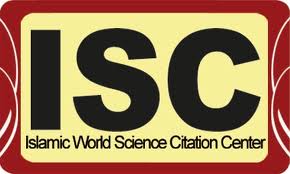Modelling of the Pi-Shape Low-Concentrating Photovoltaic Solar Cells
DOI:
https://doi.org/10.31436/iiumej.v26i2.3175Keywords:
LCPV, Optical efficiency, Fresnel lens, Concentration ratio, Incidence angleAbstract
One of the cheapest ways to improve photovoltaic (PV) systems is to create LCPV systems with polycrystalline silicon solar cells, which require less cost and have high optical efficiency. Additional reflective mirrors were added to improve the optical efficiency of the low concentrating photovoltaic (LCPV) system based on a Fresnel lens. Pi-shaped LCPV cells were obtained and compared with an ordinary LCPV based on a Fresnel lens. The proposed LCPV shows high optical efficiency even at 50 mm of cell-lens distance, while the ordinary LCPV presents a maximum of 30% of optical efficiency. The concentration ratio of 8 suns can be achieved at 150 mm of cell-lens distance at the range ±20° of the incidence angle. When the cell-lens distance is 100 mm or 125 mm, the optical efficiency is more than 80%, and the concentration ratio (CR) is more than 2 suns at the range of incidence angle ±25°. The proposed LCPV design helps to work the system at ±25° without the help of a solar tracking system. Hence, when developing the LCPV system, increasing the acceptance angle might reduce the work of solar tracking systems and the tracking errors. Good irradiance uniformity can be achieved, and the acceptance angle can be increased.
ABSTRAK: Salah satu cara termurah bagi menambah baik sistem fotovoltaik (PV) adalah dengan mencipta sistem LCPV menggunakan sel solar silikon polihabluran, di mana kos lebih rendah dan kecekapan optik tinggi. Bagi meningkatkan kecekapan optik fotovoltaik rendah tumpuan (LCPV) berasaskan kanta Fresnel, cermin pantulan tambahan diperlukan dan bentuk Pi LCPV diperolehi dan dibanding dengan LCPV biasa berasaskan kanta Fresnel. LCPV yang dicadangkan ini menunjukkan kecekapan optik tinggi walau pada jarak 50 mm antara sel dan kanta, manakala LCPV biasa mencapai kecekapan optik maksimum sebanyak 30%. Nisbah tumpuan sebanyak 8 kali pencahayaan matahari dapat dicapai pada jarak 150 mm antara sel dan kanta dalam julat sudut kejadian ±20°. Apabila jarak antara sel dan kanta sebanyak 100 - 125 mm, kecekapan optik adalah melebihi 80% dan nisbah tumpuan (CR) melebihi 2 pencahayaan matahari dalam julat sudut kejadian ±25°. LCPV yang dicadangkan ini dapat membantu sistem beroperasi pada julat sudut ±25° tanpa bantuan sistem penjejak suria. Oleh itu, dengan meningkatkan sudut penerimaan sistem LCPV semasa mencipta sistem, ini berkemungkinan mengurangkan keperluan sistem penjejak suria dan mengurangkan ralat penjejak, mencapai taburan pencahayaan seragam, serta meningkatkan sudut penerimaan secara keseluruhan.
Downloads
Metrics
References
Al-Shahri, O.A., Ismail, F.B., Hannan, M.A., Lipu, M.H., Al-Shetwi, A.Q., Begum, R.A., Al-Muhsen, N.F. and Soujeri, E. (2021) Solar photovoltaic energy optimization methods, challenges and issues: A comprehensive review. Journal of Cleaner Production, 284, 125465. https://doi.org/10.1016/j.jclepro.2020.125465
Emami Razavi, S.M., Jahangir, M.H. and Mousavi, S. (2019) A review study about photovoltaic systems and the energy payback time calculation for selected modules. Journal of Renewable Energy and Environment, 6(3): 38-49.
Obeidat, F., 2018. A comprehensive review of future photovoltaic systems. Solar Energy, 163:545-551. https://doi.org/10.1016/j.solener.2018.01.050
Kabeel, A.E., Abdelgaied, M., Sathyamurthy, R. and Kabeel, A. (2021) A comprehensive review of technologies used to improve the performance of PV systems in a view of cooling mediums, reflectors design, spectrum splitting, and economic analysis. Environmental Science and Pollution Research, 28:7955-7980. https://doi.org/10.1007/s11356-020-11008-3
Alam, M.R., Bhuiyan, I.U. and Mohammad, N. (2023) Variability Assessment of Solar Irradiance for the Safe Grid Integration of Solar Photovoltaic Power Plants. Journal of Renewable Energy and Environment.
Xiao, M., Tang, L., Zhang, X., Lun, I.Y.F. and Yuan, Y. (2018) A review on recent development of cooling technologies for concentrated photovoltaics (CPV) systems. Energies, 11(12):3416. https://doi.org/10.3390/en11123416
Nath Tiwari, G., Singh, S. and Singh, Y.K. (2023) Effect of Solar Cell Materials on Energy Matrices of GISPVT System. Journal of Renewable Energy and Environment.
Hosenuzzaman, M., Rahim, N.A., Selvaraj, J., Hasanuzzaman, M., Malek, A.A. and Nahar, A. (2015) Global prospects, progress, policies, and environmental impact of solar photovoltaic power generation. Renewable and sustainable energy reviews, 41:284-297. https://doi.org/10.1016/j.rser.2014.08.046
Bagher, A.M., Vahid, M.M.A. and Mohsen, M. (2015) Types of solar cells and application. American Journal of optics and Photonics, 3(5):94-113. https://doi.org/10.11648/j.ajop.20150305.17
RTIMI, B., RAJAB, R., BENHMIDENE, A. and CHAOUACHI, B. (2020) October. A review on a comparative study between concentrator panel CPV and conventional panel PV. In 2020 11th International Renewable Energy Congress (IREC) 1-6. IEEE. https://doi.org/10.1109/IREC48820.2020.9310375
Arshad, R., Tariq, S., Niaz, M.U. and Jamil, M. (2014) April. Improvement in solar panel efficiency using solar concentration by simple mirrors and by cooling. In 2014 international conference on robotics and emerging allied technologies in engineering (iCREATE) 292-295. IEEE. https://doi.org/10.1109/iCREATE.2014.6828382
Reis, F., Brito, M.C., Corregidor, V., Wemans, J. and Sorasio, G. (2010) Modeling the performance of low concentration photovoltaic systems. Solar energy materials and solar cells, 94(7), pp.1222-1226. https://doi.org/10.1016/j.solmat.2010.03.010
Cole, A., Baistow, I., Brown, L., Devenport, S., Heasman, K.C., Morrison, D., Whyte, G. and Bruton, T.M. (2009) March. Technological and financial aspects of laser grooved buried contact silicon solar cell based concentrator systems. In 2nd International Workshop on Concentrating Pholtovoltaic Power Plants: Optical Design and Grid Connection 9-10.
Baig, H., Heasman, K.C., Sarmah, N. and Mallick, T. (2012)October. Solar cells design for low and medium concentrating photovoltaic systems. In AIP conference proceedings 1477:98-101. American Institute of Physics. https://doi.org/10.1063/1.4753843
Amanlou, Y., Hashjin, T.T., Ghobadian, B., Najafi, G. and Mamat, R. (2016) A comprehensive review of uniform solar illumination at low concentration photovoltaic (LCPV) systems. Renewable and Sustainable Energy Reviews, 60:1430-1441. https://doi.org/10.1016/j.rser.2016.03.032
Alnajideen, M. and Gao, M. (2022) A new configuration of V-trough concentrator for achieving improved concentration ratio of> 3.0 x. Solar Energy Materials and Solar Cells, 245:111877. https://doi.org/10.1016/j.solmat.2022.111877
Parupudi, R.V., Singh, H. and Kolokotroni, M. (2020) Low Concentrating Photovoltaics (LCPV) for buildings and their performance analyses. Applied Energy, 279:115839. https://doi.org/10.1016/j.apenergy.2020.115839
Barbón, A., Ayuso, P.F., Bayón, L. and Fernández-Rubiera, J.A. (2022) Non-uniform illumination in low concentration photovoltaic systems based on small-scale linear Fresnel reflectors. Energy, 239:122217. https://doi.org/10.1016/j.energy.2021.122217
Schuetz, M. A., Shell, K. A., Brown, S. A., Reinbolt, G. S., French, R. H., & Davis, R. J. (2012). Design and construction of a? 7× low-concentration photovoltaic system based on compound parabolic concentrators. IEEE journal of photovoltaics, 2(3):382-386. https://doi.org/10.1109/JPHOTOV.2012.2186283
Sangani, C. S., & Solanki, C. S. (2007). Experimental evaluation of V-trough (2 suns) PV concentrator system using commercial PV modules. Solar energy materials and solar cells, 91(6):453-459. https://doi.org/10.1016/j.solmat.2006.10.012
Yadav, P., Tripathi, B., Lokhande, M., & Kumar, M. (2013). Effect of temperature and concentration on commercial silicon module based low-concentration photovoltaic system. Journal of Renewable and Sustainable Energy, 5(1). https://doi.org/10.1063/1.4790817
Zahedi, A. (2011). Review of modelling details in relation to low-concentration solar concentrating photovoltaic. Renewable and Sustainable Energy Reviews, 15(3):1609-1614. https://doi.org/10.1016/j.rser.2010.11.051
Dosymbetova, G., Mekhilef, S., Saymbetov, A., Nurgaliyev, M., Kapparova, A., Manakov, S., ... & Koshkarbay, N. (2022). Modeling and Simulation of Silicon Solar Cells under Low Concentration Conditions. Energies, 15(24):9404. https://doi.org/10.3390/en15249404
Dosymbetova, G., Mekhilef, S., Orynbassar, S., Kapparova, A., Saymbetov, A., Nurgaliyev, M., ... & Koshkarbay, N. (2023). Neural Network based Active Cooling System with IoT Monitoring and Control for LCPV Silicon Solar Cells. IEEE Access. https://doi.org/10.1109/ACCESS.2023.3280265
Pan, J. W., Huang, J. Y., Wang, C. M., Hong, H. F., & Liang, Y. P. (2011). High concentration and homogenized Fresnel lens without secondary optics element. Optics communications, 284(19):4283-4288. https://doi.org/10.1016/j.optcom.2011.06.019
El Himer, S., Ahaitouf, A., El-Yahyaoui, S., Mechaqrane, A., & Ouagazzaden, A. (2012). A comparative of four secondary optical elements for CPV systems. In AIP Conference Proceedings (Vol. 30003, No. 2018). https://doi.org/10.1063/1.5053502
Renno, C. (2022). Characterization of spherical optics performance compared to other types of optical systems in a point-focus CPV system. Thermal Science and Engineering Progress, 29:101201. https://doi.org/10.1016/j.tsep.2022.101201
Akisawa, A., Hiramatsu, M., & Ozaki, K. (2012). Design of dome-shaped non-imaging Fresnel lenses taking chromatic aberration into account. Solar Energy, 86(3):877-885. https://doi.org/10.1016/j.solener.2011.12.017
Chouidira, M., Ihaddadene, N., Ihaddadenea, R., Jed, M. E. H., & Kherbiche, Y. (2023). An Experimental Study on the Effect of Surface Orientation and Inclination on Incident Solar Irradiation: Application to Buildings. Journal of Renewable Energy and Environment.
Ullah, I. (2021). Optical design of centered-receiver trough-based CPV system. Journal of Photonics for Energy, 11(3):035502-035502. https://doi.org/10.1117/1.JPE.11.035502
Yadav, P., Tripathi, B., Pandey, K., & Kumar, M. (2015). Investigating the charge transport kinetics in poly-crystalline silicon solar cells for low-concentration illumination by impedance spectroscopy. Solar Energy Materials and Solar Cells, 133:105-112. https://doi.org/10.1016/j.solmat.2014.10.031
Kuttybay, N., Mekhilef, S., Koshkarbay, N., Saymbetov, A., Nurgaliyev, M., Dosymbetova, G., ... & Bolatbek, A. (2024). Assessment of solar tracking systems: A comprehensive review. Sustainable Energy Technologies and Assessments, 68, 103879. https://doi.org/10.1016/j.seta.2024.103879
Wiesenfarth, M., Anton, I., & Bett, A. W. (2018). Challenges in the design of concentrator photovoltaic (CPV) modules to achieve highest efficiencies. Applied Physics Reviews, 5(4). https://doi.org/10.1063/1.5046752
Victoria, M., Askins, S., Herrero, R., Antón, I., & Sala, G. (2016). Assessment of the optical efficiency of a primary lens to be used in a CPV system. Solar Energy, 134:406-415. https://doi.org/10.1016/j.solener.2016.05.016
Cvetkovic, A., Mohedano, R., Gonzalez, O., Zamora, P., Benitez, P., Fernandez, P. M., ... & Miñano, J. C. (2011, December). Performance modeling of Fresnel?based CPV systems: effects of deformations under real operation conditions. In AIP Conference Proceedings 1407:74-78. American Institute of Physics. https://doi.org/10.1063/1.3658298
Ullah, I. (2014). Development of Fresnel-based concentrated photovoltaic (CPV) system with uniform irradiance. Journal of Daylighting, 1(1):2-7. https://doi.org/10.15627/jd.2014.1
Mahalakshmi, K., Reddy, K. S., & Subrahmanyam, A. (2022). Outdoor degradation evaluation of multi-junction solar cell for four Fresnel concentrated photovoltaic systems. International Journal of Sustainable Energy, 41(11):1958-1972. https://doi.org/10.1080/14786451.2022.2125517
Shanks, K., Senthilarasu, S., & Mallick, T. K. (2016). Optics for concentrating photovoltaics: Trends, limits and opportunities for materials and design. Renewable and Sustainable Energy Reviews, 60:394-407. https://doi.org/10.1016/j.rser.2016.01.089
Downloads
Published
How to Cite
Issue
Section
License
Copyright (c) 2025 IIUM Press

This work is licensed under a Creative Commons Attribution-NonCommercial 4.0 International License.
Funding data
-
Ministry of Education and Science of the Republic of Kazakhstan
Grant numbers AP19574454






















